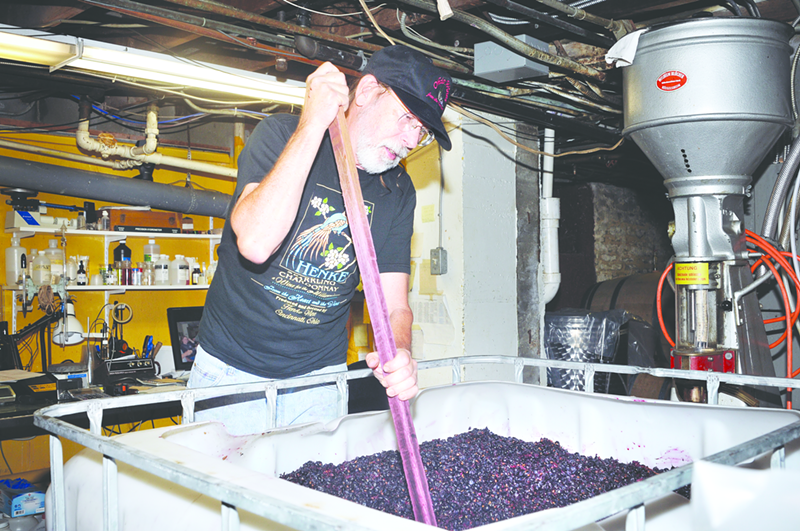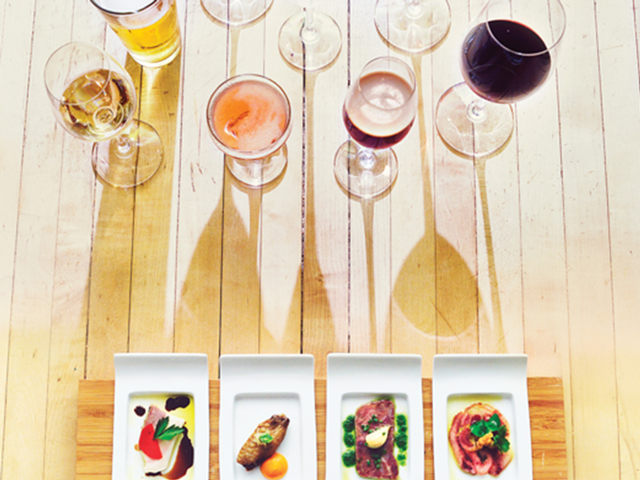California might be the heart of American wine country today, but in 1859 Ohio was the nation’s leading commercial producer of vino. With more than 3,000 acres of grapes growing along the Ohio River and an epicenter here in Cincinnati, we pretty much dominated the 19th century wine scene, so much so that poet Henry Wadsworth Longfellow even immortalized our vineyards in his poem, “Catawba Wine.”
“And this Song of Vine This greeting of mine, The winds and the birds shall deliver, To the Queen of the West, In her garlands dressed, On the banks of the Beautiful River.”
In the poem, we’re the Queen of the West and that beautiful river he’s writing about is ours. But the vines? They were Nicholas Longworth’s, founding member of the Cincinnati Longworths and “father of the American wine industry” (a title sometimes shared with Thomas Jefferson).
Like most lawyers, Nicholas Longworth enjoyed alcohol. And like most 1800s drinkers, he noticed that the current American wine — produced from a cross between North American and European grapes — kind of sucked. So Longworth planted a new grape varietal, the catawba, along the river and started producing both still and sparkling wines influenced by the traditions of Champagne, France. His grapes, which could withstand cold Ohio winters, produced an affordable, semi-sweet drink that was the first American wine to gain wide acclaim in Europe.
When the settlers arrived in Jamestown, establishing a viable American wine industry became of paramount importance, mostly so England wouldn’t have to buy wine from France and Spain. But it wasn’t until Longworth’s catawba that we were finally launched into international and commercial consciousness. A reviewer from The Great Exhibition of 1851 in London declared, “Cincinnati has become the chief seat of wine manufacture in the United States,” and everyone from German immigrants in Ohio to the finest European households drank Longworth’s wine.
Then the bubble burst.
Crop diseases like black rot decimated the Ohio grape population, the Civil War eliminated the healthy workforce and then the death knell tolled for Ohio wineries: Prohibition. Although during Prohibition some wineries stayed open to produce juices and jellies, for all intents and purposes the Ohio wine scene died and wasn’t resurrected until the latter half of the 20th century.
During the 1960s and ’70s, interest in Ohio wines re-emerged when growers discovered that French-American hybrid grapes flourished in the Lake Erie region’s climate. Today, Ohio vineyards can grow pretty much everything from chardonnay to riesling to cabernet franc, and we are once again among the top 10 wine producers in the U.S., vinting more than 1.1 million gallons every year. But, sadly, Cincinnati never took back her vine-y throne.
Most Cincinnati wineries import their grapes from Lake Erie, California, Pennsylvania and/or New York, and then produce their wine on premises. It’s still a Cincinnati wine made in a Cincinnati winery even if the winery doesn’t have its own vineyard. (The appellation on local wine labels will tell you where the grapes used to produce the wine were grown.)
By eliminating the space and growing constraints necessary to run a vineyard, wineries are able to pop up anywhere, even in an urban environment, and the city of Cincinnati is home to multiple successful and award-winning open-to-the-public urban wineries: Henke Winery, Meier’s Wine Cellars, Vinoklet Winery and Woodstone Creek.
So take a weekend to explore our local wine scene, and make the urban wine trail trek from Meier’s Wine Cellars in Silverton all the way to Vinoklet Winery in Colerain (Meier’s opens the earliest and Vinoklet serves a buffet dinner on the weekends), sampling some of the nation’s finest wines along the way.
Meier’s Wine Cellars
Tastings: 9 a.m.-5 p.m. Tuesday-Saturday; $1 per wine
Try the: #44 Cream Sherry dessert wine
Meier’s Wine Cellars is Ohio’s oldest and largest winery, and stepping inside the wood-lined tasting room is like being transported back in time. Cozily reminiscent of a German grandmother’s house, the tasting room is comfortable with a big wooden bar, lots of ski-lodge-esque tables and a stone fireplace. The walls are lined with Meier’s ephemera, and you can take in the company and family history just by looking at the old advertising signs and vintage wine and grape juice bottles in the display cases.
Today the company produces more than 45 different types of wines, sherry and a line of sparkling grape juice from Native American grape varieties — and you can try all of them. Just check your selections on a paper “wine and non-alcoholic beverage menu,” and a friendly server or bartender will bring you your selections. Many of their wines are on the sweeter side, with the menu heavily skewed toward fruit and dessert wine choices, but they are also the only local importers of the German Jakob Demmer brand of white wines. 6955 Plainfield Road, Silverton, 513-891-2900, meierswinecellars.com.
Woodstone Creek
Tastings: 1-6 pm. Saturday; $12 for five wines including a souvenir wine glass, $5 for one craft spirit tasting
Try the: Mead and their Cincinnati Vodka, rated “Highly Recommended” by the Beverage Testing Institute
Woodstone Creek is the first winery and licensed microdistillery in Ohio. It produces 100-200 cases of wine, mead and distilled spirit each year.
Currently housed in a repurposed 1930s industrial stamping factory off Dana Avenue, the concrete building’s modest exterior belies the intimate and informal visitor experience inside. Owner/certified brewmaster/mead mazer/master distiller/winemaker Don Outterson and his wife will welcome you into the wood-paneled tasting room, located in the factory president’s former office, and gladly give you a tour of the aging barrels maturing in the hallway next door.
A true artisan winery and distillery, Woodstone’s offerings change seasonally. Their wine list varies between 15 to 25 selections and the distillery pot still produces limited runs (they only bottle two to five barrels of spirits a year) of brandy, honey liqueur, five-grain bourbon, single malt whisky, rum, gin, bierschnaaps and vodka.
Sitting at the giant 1930s mahogany bar, you can taste anything they have in-house. One side of their tasting menu lists wines and honey wines with tasting notes, and the other side features their craft spirits with descriptions. Bonus: You get to keep the wine glass and shot glass. 3641 Newton Ave., Norwood, 513-569-0300, woodstonecreek.com.
Henke Winery
Tastings: 5-9 p.m. Monday-Thursday; 3-11 p.m. Friday; 11 a.m.-11 p.m. Saturday (except between 6-9 p.m. Saturday); $10 for seven wines including a souvenir wine glass
Try the: 2010 cabernet franc, awarded a silver medal at the 2012 Cincinnati International Wine Festival
Proprietor Joe Henke started his winery and restaurant in 1996 and hasn’t looked back. Located in a quaint, two-story, 1800s West Side wood house, he imports his grapes from places like California and Lake Erie, and then produces about 1,700 cases of wine per year — right under the restaurant. Each wine is bottled by volunteers on-site and labeled by hand.
The tasting room is carpeted, comfortable and lined with Henke’s award-winning wines — each wearing its own medal. In the 2012 Ohio Wine Competition alone, his 2011 cellar blush won best of show and his 2010 vendage a trois, 2011 vin de rouge and 2010 chardonnay all won gold. Tasting selections range from dry to sweet reds and dry to slightly sweet whites to champagne and sweet blush wines. Pair your wines with an item from their full menu, or just do the $10 seven-wine tasting and take your souvenir glass home with you. 3077 Harrison Ave., Westwood, 513-662-9463, henkewine.com.
Vinoklet Winery
Tastings: Noon-6 p.m. Tuesday; noon-9 p.m. Wednesday and Thursday; noon-11 p.m. Friday and Saturday; 1-5 p.m. Sunday ; $1 per wine
Try the: Traminette, awarded double gold at the 2012 Indianapolis International Wine Competition, or the Brother Joe or La Dolce Vita, which both won silver
Located on 30 acres of greenery and ponds in Colerain, this multiple award-winning winery is also the only working winery with a vineyard in Hamilton County, which means all of their wines are produced with grapes grown and cultivated in Cincinnati.
A hugely popular wedding destination because of its scenic location, the winery also hosts tastings and “grill your own” dinners on the weekends. Visit their gazebo, patio or solarium to enjoy your vino with a view. 11069 Colerain Ave., Colerain, 513-385-9309, vinokletwines.com.






